Project 667BDR ‘Kalmar’ nuclear missile attack submarines
 14 ballistic submarines (Delta III).
14 ballistic submarines (Delta III).
Soviet Cold War Subs
Pr.613 Whiskey | Pr.611 Zulu | Pr.615 Quebec | Pr.633 Romeo | Pr.651 Juliet | Pr.641 Foxtrot | Pr.641 buki Tango | Pr.877 KiloPr.627 kit November | Pr.659 Echo I | Pr.675 Echo II | Pr.671 Victor I | Pr.671RT Victor II | Pr.671RTMK Victor III | Pr.670/670M skat Charlie | Pr.705 lira Alfa | Pr.949 antey Oscar | Pr.945 Sierra | Pr.971 bars Akula | Pr.885 graney Yasen | Pr. 545 Laika
Pr.629 Golf | Pr.658 Hotel | Pr.667A Yankee | Pr.667B Murena Delta I | Pr.667D Delta II | Pr.667BDR Kalmar Delta III | Pr.667 BDMR delfin Delta IV | Pr. 941 akula Typhoon | Pr.995 borei Dolgorukiy | Pr.09851 Khabarovsk
The Delta III class SSBNs of the ex-Soviet, now Russian Navy are originally known as the Project 667BDR Kaľmar (Squid): Fourteen large ballistic missile submarine, double hulled design, within low magnetic steel outer hull and designed around their sixteen new RSM-50 R-29R “Vysota” missiles. They were destined to replace the Yankee class. Fourteen were built at Severnoye Mashinostroitelnoye Predpriyatie Severodvinsk or “Sevmash” between 1974 and 1982, and so they served until recently, just one is still listed as active today, the remainder are in reserve, all retired from 1996. #coldwar #ussr #sovietnavy #sovietskyflot #ssbn #ballisticsubmarines
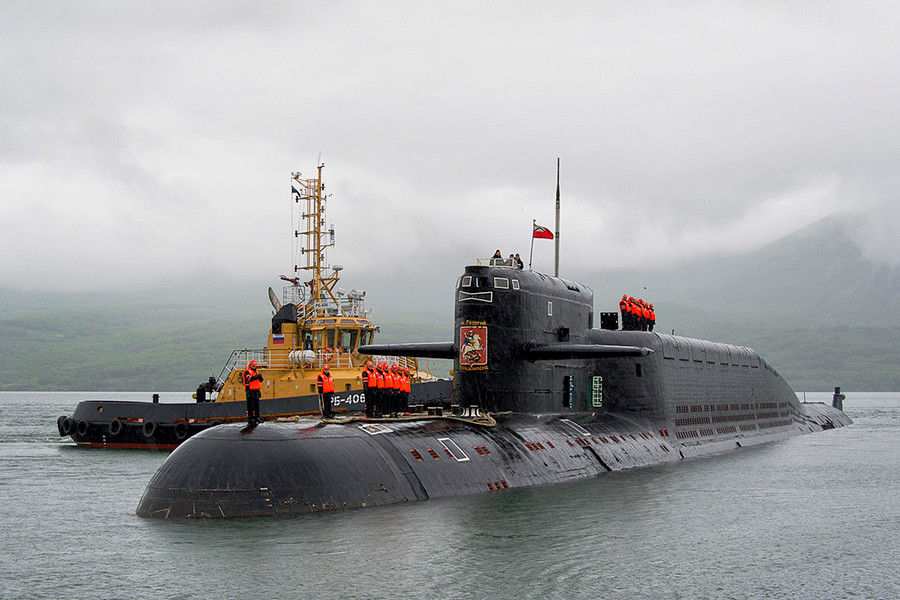
K-433 Svyatoy Georgiy Pobedonosets in the 2000s, shortly before decommission.
Development
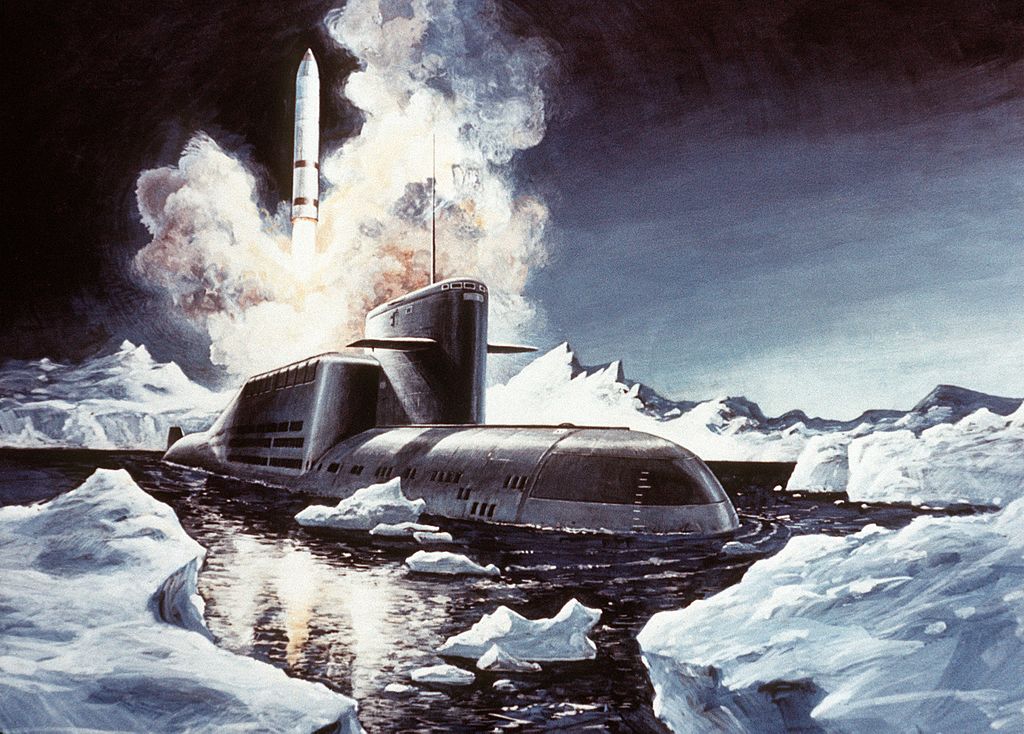
Artist view on a review of Soviet military power, 1985.
The technical description for the planned replacement for the early late 1960s Yankee class and their requirements were published already in 1972. Project 667BDR was started at Rubin Central Design Bureau for Marine Engineering under the leadership of chief designer Sergeiy Nikiticz Kovalev. She was to be a successor to the project 667BD delta II, itself closer to the Delta I with just more missiles. What NATO classed as Delta III were aimed at achieving greater discretion and use better, longer range and more accurate ballistic missiles, and be significantly quieter.
The egenral design was very much a repeat of the Delta II, but with some differences. They shared the same hull, but displacement rose to 10,500 tonnes surfaced versus 10,000, and 13,250t submerged versus 12,750t. But the hull dimensions were the same. The next Delta IV (BDRM delfin) were longer and taller.
Design of the class
Hull and general design
The hull is divided into ten waterproof sections with very thick bulkheads, 1st, 3rd, and 10th sections being special emergency sections with each their own escape hatches. Extra protection was provided by transverse struts to increase pressure resistance when running deeper underwater compared to the rest of the pressure hull. As fire hazard was a constant nightmare for Soviet subs, a new modular freon firefighting system was installed for the first time, with better automation and more accessible portable equipments. To also increase crew’s rest and performance, a solarium and gymnasium were installed in addition to a sauna for officers and NCOs. They had the same general outlook, with a similar sail, fit exactly the same way with two forward diving planes, but with some minor differences in the masts arrangement. The most obvious changes, were on one hand, the buffier, taller missile compartment, a bit longer and wider, with a taller hump “shouldering” the sail nearly to its top, and differently shaped and placed water scoops in the outer hull. Like previous designs they had two propeller shafts and a top nose sonar with bow tubes. Structural strenght had been pushed in order to dive deeper, and if the normal depth was registered at 350 m (1200 ft) in normal operations, but they are believed to be capable of diving below 580 m (1900 ft), which was the test depth. Calculations are leaning to a crush depth around 700-800 m (2500+ ft).
Powerplant
The main propulsion system, OK-700A, consists of two pressurized water reactor VM-4S (2×90 MW) with two steam turbines giving 60,000 shaft horsepower (45,000 kW) to two five-bladed, fixed-pitch shrouded propellers with improved hydro-acoustic characteristics. Two back-up TG-3000 turbogenerators were also installed. Average period between refuelling and overhaul is about ten years. This was the exact same powerplant as on the Delta I-II. Only safety redundancy was improved and sound-absorbing measure, like suspension of all main gears.
It is believed they also had the same outer hull coating with small runber-type sound absorbing bricks as well. They had five-bladed propellers.
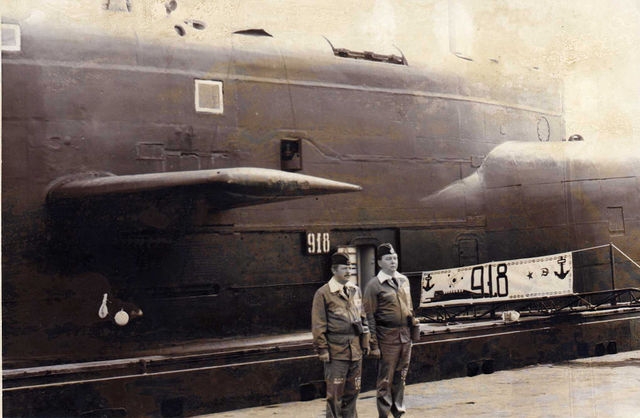
Conning tower
Armament
The main feature of the design was their new battery of larger, taller missiles, the RSM-50 R-29R “Vysota”. They also did not dropped two stern 406 mm tubes and concentrated on their four bow tubes. The Delta IV would get rid of these stern tubes. The Delta III even included some anti-helicoptyer armament, to be deployed on the sail once surfaced, a single Strela-2M SAM (8 9M32M).
Main: 16 SLBM
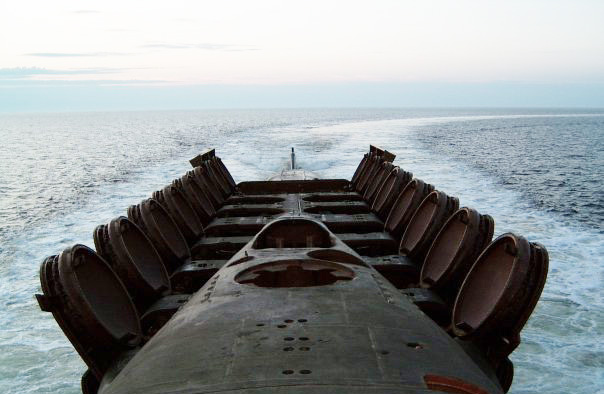
The R-29 Vysota were a family of 3rd gen. Soviet submarine-launched ballistic missiles designed by Makeyev Rocket Design Bureau. They all use astro-inertial guidance systems for improved accuracy,
and the first variant was deployed in 1974. They were known as 4K75 (GRAU) with the NARO DoD designation being SS-N-8 Mod 1 “Sawfly”. Under SALT treaty they were designated as RSM-40.
They equipped the upgraded Delta I and Delta II.
But for the Delta III, the second evolution of the design was chosen, R-29R (1978), GRAU 4K75R, NATO SS-N-18 Mod 1 “Stingray” (SALT designation RSM-50). They presented the advantage of powerful 500 kt MIRV, so a potential of 48 nuclear heads and targets per submarine in a full salvo.
This was improved on the next R29RK (7 MIRV) whereas the R29L had a single 450 kt thermonuclear warhead (30x Hiroshima).
⚙ specifications R-29R |
|
| Weight | 35,300 kg |
| Dimensions | 14.40 x 1.80 m, span 1.80 m |
| Propulsion | 2 stages solid |
| Speed | Supersonic in entry |
| Range | 6,500 km (4,038 miles) |
| Guidance | Astro-inertial |
| Ceiling | Space |
| Accuracy | >1 km. |
| Payload | 1650 kg, 3x 500 kt MIRV |
R-29RK (SS-N-18 Mod 2 “Stingray”): 34,388 kg, same range but 7x 100 kt MIRV (112 total)
R-29RL (SS-N-18 Mod 3 “Stingray”): 35,300 kg, 9,000 km (5,592 miles) range, single 450 kt warhead.
Torpedoes
The Delta II still carried the same hull, and thus, retained the same arrangement of two additional bow tubes for 406 mm torpedoes (mostly defensive, for the MG-44 decoy system operating under 250 m, 6 reloads) and four bow tubes with a large section of torpedoes (16 in reserve). These could be launched under 400m. The Delta II had the 53-61M, the Delta III had a more modern and generous array:
-SET-65:
7.8 m, 1.740 kg, 205 kg PL, Contact fuse 10 m radius mag. prox. fuse Active/passive acoustic seeker 800 m, Wire, twin prop wakeless 40 kt 16 km 400 m sub.
-SAET-60M:
7.8 m, 1.855 kg, 300 kg PL, same, no Wire guidance, 42 kt (13 km/42 kt, 15 km/35 kt)
-53-65K:
7.8 m, 2.070 kg, 307 kg PL, Active acoustic wake homing, 2TF turbine engine 44 kts RA 19 km, 100 m depth.
-53-65M:
7.95 m, 2.100 kgn 307 kg PL, Magn. prox. fuse, Active acoustic wake homing, 5DT-3 turbine 1.350 kW 44/70 knots, 14-24 km RA, 100 m depth.
URPK-6 Vodopad-PL SSM
The РПК-6 Водопад, “waterfall” is a 533 mm ASW missile deployed since 1981 (SS-N-16 “Stallion”) with a solid-fuel rocket engine, dual-role to carry a 400 mm anti-submarine torpedo or nuclear depth charge. It was used in the 83R, 84R variants and brought a considerable reach in defence to these SSBNs. They were the first so-fitted, cmbined SAMs and SSM/ASuM missiles. Note that most 553 mm torpedoes had alternative nuclear warheads.
Development started in December 1969, lead developer was OKB Novator (OKB-8) but it was only Adopted by the Navy in 1981. Once ejected to the surface, the missile turns on its solid-fuel jet engine, left the water and flew to its designated target, then the rocket drops its warhead, landing by parachute, and the 400-mm UMGT-1 electric torpedo could home to range at 8 km, down to to 500 m at 41 knots. Full data
⚙ specifications URPK-6 Vodopad-PL |
|
| Weight | Unknown, c1800 kgs |
| Dimensions | |
| Propulsion | Solid rocker booster |
| Range/speed setting | 50 km (22 nmi) |
| Warhead | Nuclear depth charge or 400 mm torpedo |
| Guidance | Inertial guidance |
Sensors
-MRK-50 Kaskad radar: Full data.
-MGK-400 Rubikon sonar: 12 tracked targets sim. range 16 km subs 0.05 Pa/Hz noise, 100 km for 10 Pa/Hz. Full data
-MRP-10M Zaliv-P ECM suite: no data
-MG-44 Korund-1 decoys: no data
-Almaz-BDR CCS: no data
Note: K-355 differed by having the MGK-100 Kerch’ sonar.

Colored, shadowed profile by Mike1979russia, CC
⚙ Delta III specifications |
|
| Displacement | Surfaced 13,500 tons, Submerged 18,200 tons |
| Dimensions | 166 x 12.3 x 8.7m (545 x 40 x 29 ft) |
| Propulsion | OK-700A (two VM-4S (2*90 MW) PWR), 2 steam turbines: 44,700 kW (59,900 shp) |
| Speed | 14 knots (26 km/h; 16 mph) surf. 24 knots (44 km/h; 28 mph) sub. |
| Range | Unlimited, 90 days food supplies |
| Armament | 16× RSM-50 R-29R “Vysota” SLMBs, 4× bow 533 mm TTs (16 torpedoes) |
| Sensors | MRK-50 Kaskad, MGK-400 Rubikon, MRP-10M Zaliv-P, MG-44 Korund-1, Almaz-BDR CCS |
| Depth | Normal 320 m (1,050 ft), max 400 m (1,300 ft) |
| Crew | 40 officers, 90 enlisted |
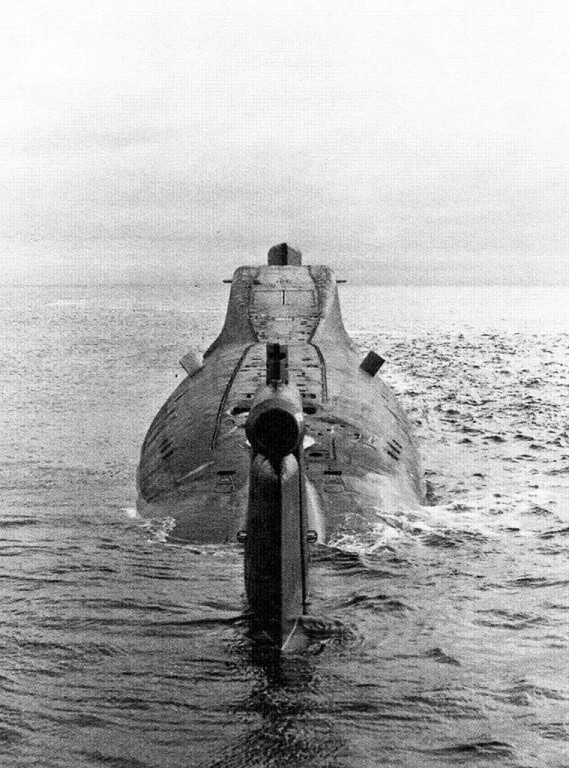
Aft view of K-211
Variant: “Delta Stretch” (BS-136)

Originally built as K-136, she was originally part of the 339th Brigade of the Northern Fleet, 13th submarine division, 3rd Submarine Flotilla based in Olenya Guba Bay. On March 22, 1996, she was assigned as a special-purpose nuclear submarine under the new pennant KS-129 and by 2002, she was modernization under project 09786, completed. During reconstruction, her missile and torpedo compartments were cut out. Due to a new insert in the middle of the hull, her length was increased from 155 to 162.5 m (532 ft). By 2006, the ship she started a new life as “special-purpose nuclear submarine”, part of the 29th separate submarine brigade, Northern Fleet.
As of 2011, she was overhauled at Zvezda, and by September 27, 2012, during the Sevmorgeo expedition, BS-136 Orenburg as now renamed, carried the deep-sea nuclear research station AS-12 submarine (project 10831 Losharik) to the North Pole. The Sevmorgeo expedition studied the high-latitude boundary of the continental shelf in the Arctic, on helaf of Russian EEZ. Three rock samples were taken at a depth of 2-2.5 km at the Lomonosov and Mendeleev ridges along the Russian continental shelf. Results were submitted to the UN Commission about Sea limitations in 2014 to claim an extended EEZ. As of 2022, BS-136 is under ovehaul at Zvezda.
Specs:
Underwater displacement 15,000 t, waterline lenght 162.5 m, 12 m wide outer hull. 2 pressurized water reactors VM-4S with a total thermal power of 180 MW, 2 gas turbines with echelon arrangement of 20,000 hp each, 2 auxiliary diesel of 3000 kW each, 2 AB groups, 2 diesel generators 460 kW each, 2 creeping electric motors, 260 hp each. For self defence she had 2 sets of “Strela-2M” SAMs.
Career of the Delta III
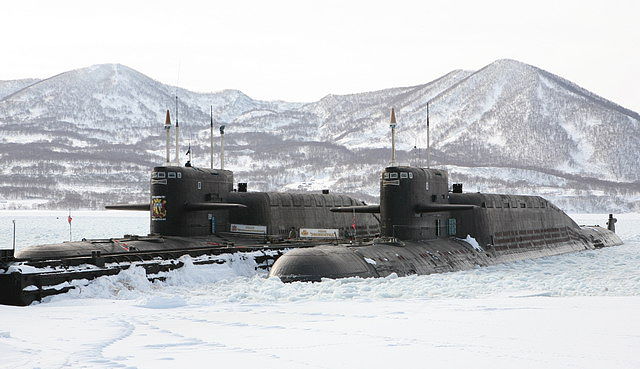
K-211 Petropavlovsk-Kamchatskiy and K-506 Zelenograd with the Northern Fleet, Murmansk-Severodvinsk
By 2024, remaining ships of that class are to be sent for recycling. The last to leave service was K-44 Ryazan in 2023, currently awaiting disposal. The special-purpose nuclear submarine BS-136 “Orenburg” was rebuilt in 1996-2002 into a carrier of ultra-small submarines and is now still active as part of the 29th submarine division of the Northern Fleet.
 K-424
K-424
K-424 was the first built at SEVMASH, Severodvinsk. She was laid down on 30 January 1974, launched on 11 February 1976 and completed 30 December 1976, in service with the Northern fleet. She was Decommissioned on 28 March 1995 and sold for scrapping. In August to October 1976, there was a state testing program carried out under Vice Admiral A.I. Sorokin. On September 11, 1976 an accident occurred. A. I. Makarenko (chief engineer) recalled they hit the bottom, destroying the fairing of the sonar, due to an error by the navigator under 210 meters at 20 knots and on an underwater rock. G. D. Pavlyuk and senior engineer A. V. Nenashev howeve managed to recover the boat. The incident was classified until the 1990s.
In January 1977, she was in the 13th submarine division, 3rd submarine flotilla of Northern Fleet, based in Olenya Bay. On January 18, 1981, a fire occurred in the 3rd compartment due to a cigarette butt in the filter in the latrine which caught fire. She surfaced and vented it out, the fire was quickly put down under prompt reactopn of Captain 1st Rank Nikolai Aleksandrovich Ivanov. There was no casualty. In May 1984 under B.F. Plyusnin she hit pack ice with her bow in emergency surfacing. On September 27, 1984, she made a successful launch from her pier in Porchnikha Bay. On October 23, 1984 while preparing to go to sea, crew error led the airborne jumper to rupture, with two sailors killed and several injured. On May 19, 1986, during a missile firing from the surface in Porchnikha Bay, the missile failed and fell onto the missile deck causing a fire extinguished by nearby fire ship. In March 1988, K-424 entered the 31st Northern Fleet sub Brigade. In 1986-1988, she was overhauled at Zvezd, Severodvinsk. Whe decommissioned by April 1996, she had performed 16 long range campaigns and 20 deployments.
 K-441
K-441
K-441 was laid down on 7 May 1974, launched 25 May 1976, developed on 31 October 1976. She was assigned to the Pacific fleet, and by December 29, 1976, became became part of the 13th Submarine Division. In 1983, she completed her first Arctic Ocean campaign. From February 1986 to November 1987, she was overhauled at Zvezda and from August to November 1988, she was moved from Yagelnaya Bay to Krasheninnikov Bay and assigned to the 25th division of the 2nd flotilla, Pacific Fleet. She was decommissioned on 28 March 1995, sold for scrapping.
 K-449
K-449
K-449 was laid down on 19 July 1974, launched on 29 July 1976 an,d completed on 5 February 1977, assigned to the Pacific Fleet. In 1981, she stayed under the ice for 26 days. In 1982, while performing her patrol with the 2nd crew under captain N.M. Kozlov with K-487 she stayed under the ice for 27 days. Later with the 1st crew (2nd rank captain A.F. Kovalenko) she stauyed under ice of 26 days. In 1983, while on duty, she colliedd with an unidentified US Navy nuclear submarine. In 1988, she was transferred to the 31st Brigade, 3rd squadron, division based at Yagelnaya Bay, Saida Bay (Gadzhievo). From December 16 to December 8, 1989 she wa soverhaul at Severodvinsk.
In August 1990, before a new assignment, she made an under ice patorl of 10 days under captain 1st rank M. N. Zikunov. From August 21 to November 6, 1990, she sailed from Yagelnaya Bay, Gadzhievo (Northern Fleet) to Krasheninnikov Bay, Vilyuchinsk and entered the Pacific Fleet under 1st Rank Captain M. N. Zikunov, with Rear Admiral A. A. Berzin on board. She done this while crossing under the ice for 12 days. On November 11, 1990, she was reassigned to the 25th Division, 2nd Squadron based at Krasheninnikov Bay. On April 28, 1992, she was reclassified and by September 1, 1998 assigned to the 16th Operational Squadron based in Vilyuchinsk.
In August 2001 she was withdrawn, transferred to the 304th Brigade of the Pacific Fleet and left in storage, laid up at Krasheninnikov Bay. In 2002, she was sent to SRZ-49 (North-Eastern Repair Center) to the 201st deactivation unit of the Pacific Fleet in Seldevaya Bay sticken on October 30, 2002, and in 2008, disposed of. Funding for her disposal as well as for her sister K-490 were provided by the US congress for environmental reasons under the the threat reduction program in cooperation with the US DoD. Disposal were submitted to strictly regulated special protocol documents. NIPTB “Onega”, FSUE “TsKB MT” Rubin”, FSUE “OKBM” and FSUE “51 TsKTIS VMF” took part in the operation. In 2009, three compartment of the reactor unit were trabsferred for long-term storage facility.
 K-455
K-455
K-455 was laid down on 16 October 1974, launched on 16 August 1976 and completd on 30 December 1976. She was assigned to the Pacific fleet and placed in in reserve from 1998–99, probably decommissioned 2024.
 K-490
K-490
K-490 was laid down on 6 March 1975, launched on 27 January 1977 anc commissioned on 30 September 1977, she was assigned to the Pacific fleet and placed in reserve from 1998–99, probably decommissioned 2024.
 K-487
K-487
She was laid down on 9 June 1975, launched on 4 April 1977 anc completed on 27 December 1977, assigned to the Northern Fleet. In reserve from 1998–99, decommissioned as of 2024.
 K-496
K-496
She was renamed at some point. Borisoglebsk. Laid down 23 September 1975, launched 13 August 1977 and completed on 30 December 1977, assigned to the Northern fleet. In 1983, she amde her first North Pole deployment. A leak occurred in her steam generator in the primary circuit of the reactor and by 1985-1986, she underwent an overhaul, with the replacement of her steam generators. In 1986, she made another North Pole patrol as part of the 31st Division at Yagelnaya Bay. In 1991, she had a new overhaul and modernisation of her sonar suite. In March 1993 she collided with the allegeldy the USS Grayling, and has to be repaired. The Russian investigation established that USS Grayling was tracking her until lost her position and collided (possible “Mad Ivan”). From 1998 she was financed by the city of Borisoglebsk. In 2001-2005, she was converted to the Volna ballistic system. In 2005, she made an orbital launch of the Volna with a Cosmos-1 satellite.
In total, from 1978 to 2005, she performed 22 long sorties, 28 patrols, firing 31 missiles, awared “E” three times.
By 2004, K-496 Borisoglebsk and K-44 Ryazan were the last Delta IIIs of the Northern Fleet. K-44 Ryazan in 2007 was transferred to the Pacific Fleet, leaving K-496 Borisoglebsk alone in overhaul by 2008. In April 2009 as she was deactivated, an agreement was found between the Russian MoD, Canadina MoD and US DoD for her safe dismantling. The unloading of spent fuel was financed by Canada, and the disposal of her hull disposal of her nuclear reactors financed by the USA. She was decommissioned on 9 December 2008, fuel discharged, now her long term storage is complete, the rest had been scrapped.
 K-506
K-506
Later renamed Zelenograd. She was laid down on 29 December 1975, launched on 26 January 1978 and completed on 30 November 1978, assigned to the Pacific fleet. On January 24, 1979, she entered the 13th division, 3rd submarine flotilla based in Olenya Guba. This sumer 1979, she made a first sortie in the Greenland Sea, under ice for 8 days with the 2nd crew under captain V. G. Vanyshev.
From August 18 to October 19, 1981, she made an under-ice trans-Arctic inter-fleet transition from Yagelnaya Bay to Krasheninnikov Bay and reassigned on November 10, 1981 to the Pacific Fleet under supervision of Vice Admiral L. A. Matushkin. On September 15, 1998 she was patronized and financed by the city of Zelenograd, taking that name as sponsored ship.
In July 2010, she was withdrawn from the Pacific Fleet, disposed of in 2016 at Zvezda. Placed in reserve by 2010, Decommissioned in June. Status unknown, likely long term reserve.
 K-211
K-211
Renamed Petropavlovsk-Kamchatskiy under Russian era service, laid down originally in 19 August 1976, launched on 13 January 1979 and completed on 28 September 1979, she was assigned to the Pacific fleet. She was initally part of the 331st separate brigade while under construction. On May 23, 1981, K-211, while en route to to her training range, she collided with a submarine, identified by fragments later to be likely a Sturgeon-class SSN. Thuis happened when tracking her and in English-language sources, it was attributed instead to the British submarine HMS Sceptre (S104) of the Swiftsure class. Her horizontal stern stabilizer was repaired and right propeller replaced.
In June 1982, while operating with the second crew (Capt. Kovalev I. E.) a design flaw in steam generators PG-4t led to a primary circuit leak. The fire was quickly extinguished. In October – December 1982 she made her first Arctic patrol and in September 1982, she was inspected by the general staff. In September-November 1984 she made a trans-Arctic passage via Olenya Guba in the Kamchatka and Krasheninnikov Bay with on board Rear Admiral Agafonov to join the 25th submarine division, 2nd submarine flotilla, Pacific Fleet in Vilyuchinsk. In 1989-1993 she was modernized at Zvezda, Bolshoi Kamen, 72 unit. In 1996, with K-223 and K-530 she made live fire tests on a coastal target.
On September 15, 1998, she was renamed “Petropavlovsk-Kamchatsky”, with the 25th submarine divisio, 16th submarine squadro and by August 7, 2007, she made another ballistic missile full launch. She hit her target at the Chizha missile range. On November 16, 2010 she made her ultimate trip to Primorye for dismantling. Disposal started in 2013 and by 2019, Rosatom specialists unloaded spent nuclear fuel from the reactors it was hoped she could be kept afloat and preserved. Removed from active service in December 2010, placed in reserve by 2012, she is still in dismantling.
 K-223
K-223
Renamed Podolsk in Russian service, laid down on 19 February 1977, launched on 30 April 1979 and completed on 27 November 1979, assigned to the Pacific fleet. In 1980, under Vice Admiral L. A. Matushkin, and captain 1st Rank D. N. Novikov, escorted by K-43 (Project 670) she sailed from Olenya Bay Guba to Krasheninnikov Bay; from the Northern to the Pacific Fleet under ice, Central Arctic. Bot commanders were awarded the title Hero of the Soviet Union. By December 11, 1980, she entered the 25th submarine division, 2nd Submarine Flotilla in Krasheninnikov Bay (Vilyuchinsk). From December 1989 to April 1994 she had an overhaul at Bolshoy Kamen and in 1996, with K-211, she made a full launch of her R-29R ballistic missiles at a coastal target. On July 18, 1998, she was renamed “Podolsk”. In May 2014, she made a long campaign in the Pacific with tactical ASW exercises and sailed to the Sea of Okhotsk for a missile launc underwater at the North-Western Chizha training ground.
On October 30, 2015, she launched an R-29R ballistic missile from the Sea of Okhotsk. In 2017, K-223 “Podolsk” was part of the 25th Division, 16th Special Submarine Sqn. based in Krasheninnikov Bay. In 2018, a tender for unloading her nuclear fuel has been announced, she was decom. on October 31, 2019, Removed from active service, dismantling is going in as of 2024.
 K-180
K-180
Laid down on 27 December 1977, launched on 8 January 1980, commissioned on 25 September 1980. She was assigned to the Pacific fleet. Placed in reserve from 2004, scrapped in 2008.
 K-433
K-433
Renamed Svyatoy Georgiy Pobedonosets in Russian service. Laid down on 24 August 1978, launched on 20 June 1980, commissioned on 15 December 1980, assigned to the Pacific fleet. Removed from active service in 2018, placed in reserve as of 2024. Full records
 K-129
K-129
Renamed BS-136, later “Orenburg” in Russian service. Laid down on 9 April 1979, launched on 15 April 1981, commissioned on 5 November 1981, assigned to the Northern fleet and between 1994 and 2002 she was converted as special purpose submarine Project 09786 (mini-submarine carrier for spec ops/rescue). Alledgedly refitted in 2021. Extant.
 K-44
K-44
The last boat of this class, she was renamed “Ryazan” in Russian service, laid down on 31 January 1980, launched 19 January 1982 and commissioned on 17 September 1982, assigned to the Pacific fleet and Decommissioned as of 2023. In reserve. Full logs
Read More/Src
Books
Conway’s all the world fighting ships 1947-1995
Links
lenta.ru/ losharik/
deepstorm.ru K-129.htm
star.ru/ tv11_02_17.pdf
deepstorm.ru/ K-424.htm
flot.com/ 923.php
web.archive.org/ trud_vakhta/tv11_02_17.pdf
navypedia.org k424 class
R-29_Vysota
on ru.wikipedia.org/
en.wikipedia.org Delta_III-class_submarine
deepstorm.ru/ /list.htm

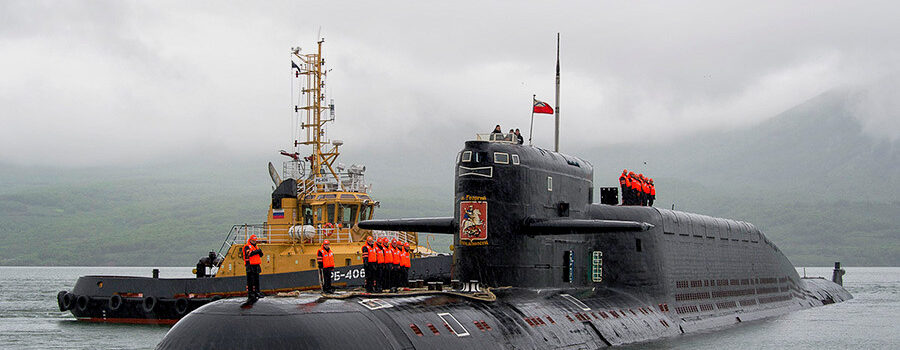
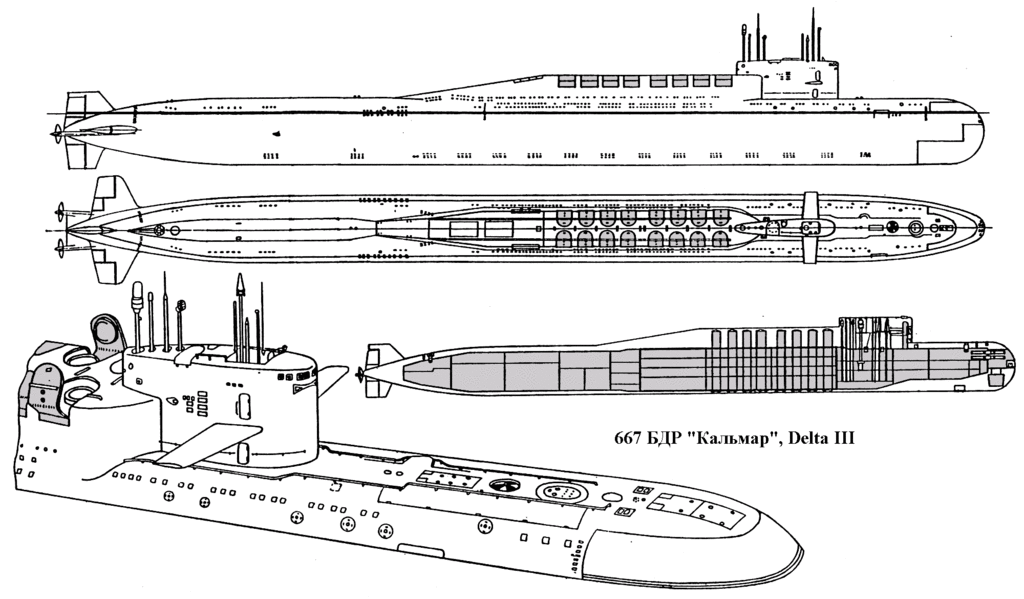
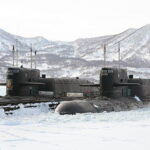
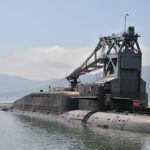
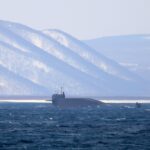

 Latest Facebook Entry -
Latest Facebook Entry -  X(Tweeter) Naval Encyclopedia's deck archive
X(Tweeter) Naval Encyclopedia's deck archive Instagram (@navalencyc)
Instagram (@navalencyc)





 French Navy
French Navy Royal Navy
Royal Navy Russian Navy
Russian Navy Armada Espanola
Armada Espanola Austrian Navy
Austrian Navy K.u.K. Kriegsmarine
K.u.K. Kriegsmarine Dansk Marine
Dansk Marine Nautiko Hellenon
Nautiko Hellenon Koninklije Marine 1870
Koninklije Marine 1870 Marinha do Brasil
Marinha do Brasil Osmanlı Donanması
Osmanlı Donanması Marina Do Peru
Marina Do Peru Marinha do Portugal
Marinha do Portugal Regia Marina 1870
Regia Marina 1870 Nihhon Kaigun 1870
Nihhon Kaigun 1870 Preußische Marine 1870
Preußische Marine 1870 Russkiy Flot 1870
Russkiy Flot 1870 Svenska marinen
Svenska marinen Søværnet
Søværnet Union Navy
Union Navy Confederate Navy
Confederate Navy Armada de Argentina
Armada de Argentina Imperial Chinese Navy
Imperial Chinese Navy Marinha do Portugal
Marinha do Portugal Mexico
Mexico Kaiserliche Marine
Kaiserliche Marine 1898 US Navy
1898 US Navy Sovietskiy Flot
Sovietskiy Flot Royal Canadian Navy
Royal Canadian Navy Royal Australian Navy
Royal Australian Navy RNZN Fleet
RNZN Fleet Chinese Navy 1937
Chinese Navy 1937 Kriegsmarine
Kriegsmarine Chilean Navy
Chilean Navy Danish Navy
Danish Navy Finnish Navy
Finnish Navy Hellenic Navy
Hellenic Navy Polish Navy
Polish Navy Romanian Navy
Romanian Navy Turkish Navy
Turkish Navy Royal Yugoslav Navy
Royal Yugoslav Navy Royal Thai Navy
Royal Thai Navy Minor Navies
Minor Navies Albania
Albania Austria
Austria Belgium
Belgium Columbia
Columbia Costa Rica
Costa Rica Cuba
Cuba Czechoslovakia
Czechoslovakia Dominican Republic
Dominican Republic Haiti
Haiti Hungary
Hungary Honduras
Honduras Estonia
Estonia Iceland
Iceland Eire
Eire Equador
Equador Iran
Iran Iraq
Iraq Latvia
Latvia Liberia
Liberia Lithuania
Lithuania Mandchukuo
Mandchukuo Morocco
Morocco Nicaragua
Nicaragua Persia
Persia San Salvador
San Salvador Sarawak
Sarawak Uruguay
Uruguay Venezuela
Venezuela Zanzibar
Zanzibar Warsaw Pact Navies
Warsaw Pact Navies Bulgaria
Bulgaria Hungary
Hungary

 Bundesmarine
Bundesmarine Dutch Navy
Dutch Navy Hellenic Navy
Hellenic Navy Marina Militare
Marina Militare Yugoslav Navy
Yugoslav Navy Chinese Navy
Chinese Navy Indian Navy
Indian Navy Indonesian Navy
Indonesian Navy JMSDF
JMSDF North Korean Navy
North Korean Navy Pakistani Navy
Pakistani Navy Philippines Navy
Philippines Navy ROKN
ROKN Rep. of Singapore Navy
Rep. of Singapore Navy Taiwanese Navy
Taiwanese Navy IDF Navy
IDF Navy Saudi Navy
Saudi Navy Royal New Zealand Navy
Royal New Zealand Navy Egyptian Navy
Egyptian Navy South African Navy
South African Navy






























 Ukrainian Navy
Ukrainian Navy dbodesign
dbodesign